#seven united provinces event
Explore tagged Tumblr posts
Text

Batangas: My Sky and Earth—An Intimate Recollection and Reflection of My Childhood in the Philippines
To celebrate the first anniversary of Batangas: My Sky and Earth, the author is thrilled to present a special Second Edition! The eBook and hardcover editions feature high-resolution photographs in both monochrome and color, while the paperback offers enhanced black-and-white images from the original release. This unique Second Edition is a heartfelt gesture of gratitude from the author to thank readers and commemorate this significant milestone.
About the Book
When Bong Serrano learned that his older brother, Boying, had cancer, the notes he had jotted down about his childhood took on new meaning. Memories of his time with his family in the Philippines came rushing back. At the center of those memories were the precious moments he'd spent with his Kuya. Faced with his brother's impending death, Bong asked himself: "What if one day I lose my memories? Who will remember us?" Thus began Bong's yearslong journey of immortalizing not only his childhood but also his country's history and traditions. Bong grew up in the southern province of Batangas, on Luzon Island. Batangas: My Sky and Earth is a celebration of that childhood. This memoir takes you into a world made rich by the intricate descriptions of life in the Philippines in the 1970s and '80s, where the family unit is close, and many households are multigenerational. From family dynamics to church duties to delicious food and the inevitable annual typhoons, Bong invites you to experience his culture from the inside. Throughout this memoir, Bong honors his childhood home and country and the memory of his beloved brother. The choice to interweave Tagalog throughout this book's pages helps to steep the story in Filipino culture further. A whole village raised this boy, and as Bong looks back on his childhood, the lessons he learned come to the foreground: clarity, forgiveness, tradition, and love.
About the Author
Bong Serrano is a proud Batangueño, hailing from the picturesque and historic province of Batangas, Philippines. His debut memoir, Batangas: My Sky and Earth, not only pays homage to his roots but also takes readers on a nostalgic journey into the heart of Filipino heritage.
Bong completed his undergraduate studies with an academic scholarship at Ateneo de Manila University and was subsequently awarded a student exchange scholarship at International Christian University in Tokyo. After dedicating several years as an international flight attendant and Japanese speaker for American Airlines, immersing himself in diverse cultures around the world, he transitioned to roles as Digital Marketing Director at both a digital marketing agency and a not-for-profit organization for men’s health in Vancouver, contributing his expertise to both organizations over a twenty-seven-year career in digital marketing.
Though Bong has called Canada home for many years, his heart remains deeply connected to Batangas, where he frequently returns to visit family and friends. He cherishes the bonds he holds dear and finds joy in sharing stories, listening to music, taking long walks along the seawall, mastering the art of cooking adobo, indulging in Asian dramas during his leisure hours, and, naturally, pursuing his passion for writing and storytelling. Bong resides in Vancouver with his life partner of over thirty years.
Bong is currently immersed in his next project, which involves writing a historical fiction. Connect with him and explore more of his work on his website at bongserrano.com.
Watch the Video Trailer
The full-length video montage of my debut memoir, premiering on YouTube for the first book signing event at Indigo on Robson Street, Vancouver, on March 3, 2024.
youtube
Second Edition Now Available in Hardcover, Paperback, and eBook
Bong Serrano Media
Amazon.ca
Amazon.com
Barnes & Noble
#batangas#memoir#non fiction#new book#autobiography#reading#childhood#childhood memories#childhood nostalgia#nostalgic#70s kids#nostalgia#80s#filipino#philippines#hardcover#paperback#ebook#kindle#kindle unlimited#ingramspark#indie#tagalog#batangueño
2 notes
·
View notes
Text
Events 8.19 (before 1930)
295 BC – The first temple to Venus, the Roman goddess of love, beauty and fertility, is dedicated by Quintus Fabius Maximus Gurges during the Third Samnite War. 43 BC – Gaius Julius Caesar Octavianus, later known as Augustus, compels the Roman Senate to elect him Consul. 947 – Abu Yazid, a Kharijite rebel leader, is defeated and killed in the Hodna Mountains in modern-day Algeria by Fatimid forces. 1153 – Baldwin III of Jerusalem takes control of the Kingdom of Jerusalem from his mother Melisende, and also captures Ascalon. 1458 – Pope Pius II is elected the 211th Pope. 1504 – In Ireland, the Hiberno-Norman de Burghs (Burkes) and Cambro-Norman Fitzgeralds fight in the Battle of Knockdoe. 1561 – Mary, Queen of Scots, aged 18, returns to Scotland after spending 13 years in France. 1604 – Eighty Years War: a besieging Dutch and English army led by Maurice of Orange forces the Spanish garrison of Sluis to capitulate. 1612 – The "Samlesbury witches", three women from the Lancashire village of Samlesbury, England, are put on trial, accused of practicing witchcraft, one of the most famous witch trials in British history. 1666 – Second Anglo-Dutch War: Rear Admiral Robert Holmes leads a raid on the Dutch island of Terschelling, destroying 150 merchant ships, an act later known as "Holmes's Bonfire". 1692 – Salem witch trials: In Salem, Province of Massachusetts Bay, five people, one woman and four men, including a clergyman, are executed after being convicted of witchcraft. 1745 – Prince Charles Edward Stuart raises his standard in Glenfinnan: The start of the Second Jacobite Rebellion, known as "the 45". 1745 – Ottoman–Persian War: In the Battle of Kars, the Ottoman army is routed by Persian forces led by Nader Shah. 1759 – Battle of Lagos: Naval battle during the Seven Years' War between Great Britain and France. 1772 – Gustav III of Sweden stages a coup d'état, in which he assumes power and enacts a new constitution that divides power between the Riksdag and the King. 1782 – American Revolutionary War: Battle of Blue Licks: The last major engagement of the war, almost ten months after the surrender of the British commander Charles Cornwallis following the Siege of Yorktown. 1812 – War of 1812: American frigate USS Constitution defeats the British frigate HMS Guerriere off the coast of Nova Scotia, Canada earning the nickname "Old Ironsides". 1813 – Gervasio Antonio de Posadas joins Argentina's Second Triumvirate. 1839 – The French government announces that Louis Daguerre's photographic process is a gift "free to the world". 1848 – California Gold Rush: The New York Herald breaks the news to the East Coast of the United States of the gold rush in California (although the rush started in January). 1854 – The First Sioux War begins when United States Army soldiers kill Lakota chief Conquering Bear and in return are massacred. 1861 – First ascent of Weisshorn, fifth highest summit in the Alps. 1862 – Dakota War: During an uprising in Minnesota, Lakota warriors decide not to attack heavily defended Fort Ridgely and instead turn to the settlement of New Ulm, killing white settlers along the way. 1903 – The Transfiguration Uprising breaks out in East Thrace, resulting in the establishment of the Strandzha Commune. 1909 – The Indianapolis Motor Speedway opens for automobile racing. William Bourque and his mechanic are killed during the first day's events. 1920 – The Tambov Rebellion breaks out, in response to the Bolshevik policy of Prodrazvyorstka. 1927 – Patriarch Sergius of Moscow proclaims the declaration of loyalty of the Russian Orthodox Church to the Soviet Union.
1 note
·
View note
Text
The Islamic Revolutionary Guards Corps (IRGC) seized a commercial ship in international waters in the Gulf on July 6, the U.S. Navy said, adding that the vessel was possibly involved in smuggling activity.
"U.S. naval forces deployed maritime assets to closely monitor the situation," U.S. Fifth Fleet spokesman Commander Tim Hawkins said.
The Navy's central command "assessed the circumstances of this event did not warrant further response," he added.
The U.S. Navy said on July 5 that it had intervened to prevent Iran from seizing two commercial tankers in the Gulf of Oman.
It said that, in both cases, the Iranian naval vessels backed off after the U.S. Navy responded to distress signals, and that both commercial ships continued their voyages.
“The Iranian Navy did make attempts to seize commercial tankers lawfully transiting international waters,” said Hawkins. “The U.S. Navy responded immediately and prevented those seizures.”
Iran said it had obtained a court order for the seizure of the Richmond Voyager tanker after it collided with an Iranian vessel.
It was the latest in a series of attacks on ships in the area since 2019.
The U.S. Navy said in a statement that the first report came at 1 a.m. when one Iranian naval vessel approached the Marshall Islands-flagged oil tanker TRF Moss. The Iranian vessel departed the scene when the U.S. Navy guided-missile destroyer USS McFaul arrived, it said.
About three hours later, the U.S. Navy received a distress call from the Bahamian-flagged oil tanker Richmond Voyager while the ship was about 30 kilometers off the coast of Oman. Another Iranian naval vessel had closed within 2 kilometers of the Richmond Voyager while hailing the tanker to stop.
The McFaul directed course toward Richmond Voyager at maximum speed as the tanker continued its transit, the Fifth Fleet said.
"Prior to McFaul’s arrival on scene, Iranian personnel fired multiple, long bursts from both small arms and crew-served weapons," the statement said. "Richmond Voyager sustained no casualties or significant damage. However, several rounds hit the ship’s hull near crew living spaces. The Iranian Navy vessel departed when McFaul arrived."
U.S. oil company Chevron confirmed to Reuters that it managed the Richmond Voyager, that its crew was safe, and that the vessel was operating normally.
Iran’s state media cited the Maritime Search and Rescue Center of Hormozgan Province in the country’s south as saying in a statement that Iran had obtained a court order for the seizure of the Richmond Voyager after it collided with an Iranian vessel carrying seven crew members.
Five people were seriously injured in the collision, the IRINN news agency said, citing the statement.
The United States in May increased the rotation of ships and aircraft patrolling the Strait of Hormuz with its partners following an uptick in Iranian merchant vessel seizures, the Fifth Fleet said.
3 notes
·
View notes
Text

In 1988 the Belkan Federation's eastern provinces took the opportunity to secede as part of the Federal Law Review. The two newly-independent (and formerly united as Galbica) nations of Gebet and Recta would sign a defense pact with Yuktobania and FATO to strengthen their military capability in the event of Belkan revanchism.
Seven years later, Belka would put the Cor Pact to the ultimate test...
1 note
·
View note
Text
The NGO Network Driving Antisemitism in Canada
Since the Hamas-orchestrated October 7, 2023 massacre, Canada has experienced a dramatic increase in violent antisemitism.1 This dangerous spike is concurrent with an increase in activity by an interconnected and coordinated network of NGOs, whose campaigns of anti-Israel demonization, antisemitism, and intimidation create a hostile environment throughout Canada. A number of the leading groups are linked to Palestinian terror organizations and hide their sources of funding.
NGO Monitor’s mapping of Canadian anti-Israel groups, partnerships, and funding shows the extent of NGO cooperation in advancing their agendas of isolating Israel and attacking the Jewish State’s supporters (and perceived supporters). This NGO network is responsible for violent public events, student encampments, statements, and legal actions. Ominously, many of these groups have publicly celebrated the Oct. 7th atrocities, and expressed support for Hamas and other Canadian-designated terrorist organizations.
The main findings from the mapping are:
There is a blatant lack of transparency regarding the funding sources that enable the NGOs in the network.
38 out of the 111 groups are registered with Canada Revenue as a business or charity. 29 organizations are known to have received some funding from the Government of Canada or provinces.
Samidoun – a Palestinian terror-linked NGO with chapters in Vancouver, Toronto and Ottawa – is one of the key groups promoting hate and incitement in Canada through its planning and promotion of numerous antisemitic events and extensive partnerships across the country.
Independent Jewish Voices (IJV), which claims to have 9 university and 18 regional chapters, has the most connections, partnering with 76 out of the 111 groups.
While small in numbers, campus organizations are prominent in the network and have partnered with many NGOs, including those that receive Canadian government funding.
On the cluster map, organizations are situated closer to other organizations with which they have more links (“force-directed layout”). Legal NGOs appear to be fairly central and connected, suggesting that they are providing important services to many of the activist groups.
This data takes on higher salience following the October 15, 2024 decision by the Government of Canada (in parallel to the United States) to list Samidoun “as a terrorist entity under the Criminal Code.” As evidenced in this mapping, Samidoun is a central node in a broader network of anti-Israel and antisemitic NGOs operating in Canada.
Recommendations
A number of NGOs represent threats to public safety and may have violated Canadian laws related to terrorism, incitement, violent extremism, and hate speech (antisemitism). Canadian authorities should systematically investigate these groups, and prosecute and take other legal action where warranted.
Samidoun was a known PFLP entity, even before Canada designated the NGO as a terror organization. Authorities should investigate whether universities, faculty, and NGOs that partnered with or hosted Samidoun and its officials could be liable for violations of Canadian law.
In particular, PYM (Palestinian Youth Movement), which has many links to the PFLP terror group, should also be banned from operating in Canada.
Canada should improve financial transparency requirements for non-profits and charities, especially for groups involved in the disruptions, intimidation and antisemitism on the campuses of public universities and in mass rallies in the public sphere.
Mapping Data
NGO Monitor divided the groups in the network into seven distinct categories: Funders, Legal, Campus, Advocacy, Research, Aid, and Bandwagon. These classifications help make sense of the complex landscape, as well as dissect the roles and influences of individual NGOs within the broader network.
Funders are the financial backbone of the network, providing the resources for NGO capabilities and reach, and enabling their anti-Israel and antisemitic activities.
Legal NGOs focus on legal advocacy, provide legal services to anti-Israeli activists, and exploit courts other legal forums to attack policies and practices they perceive as pro-Israel (“lawfare”).
Campus NGOs operate primarily within academic institutions, mobilizing students and faculty members to support radical activities in the campuses, such as illegal encampments, harassing Jewish and Israeli students, and blocking their freedom of movement.
Advocacy NGOs focus on raising awareness and generating public support for the Palestinian issue. Their activities often consist of media campaigns, public demonstrations, and other forms of outreach.
Research NGOs publishing reports and analyses, contributing propaganda to support the arguments and strategies employed by the network. These NGOs do participate in events and advocacy campaigns, however, their main contribution to the network is through their research and publications.
Aid NGOs listed here promote anti-Israel rhetoric in their publications, statements, and events, and partner with numerous anti-Israel NGOs.
Bandwagon NGOs do not have the Palestinian issue as their primary focus. Rather, in the current political environment, they choose to align with the more “hardcore” NGOs, adding visibility, resources, or ideological support. In many respects, this also represents a form of “hitching,” where an NGO adopts the anti-Israel cause to amplify their reach and impact.
NGO Monitor presents this mapping in the hope it will serve as a valuable tool for researchers and decision-makers. By understanding the structure and dynamics of this NGO network – its organization, funding, and partnerships – stakeholders can better comprehend the phenomena at play and make informed decisions.

HD image in link at top with full article.
0 notes
Text
What Happened on September 13 in Canadian History?
Canadian history, like that of many nations, is filled with significant events that have shaped its identity and development over the centuries. September 13 is a day that witnessed important battles, sporting milestones, and cultural contributions. From the decisive Battle of the Plains of Abraham to the formation of rugby unions that laid the foundation for Canadian football, this date has seen pivotal moments in the nation’s past. In this article, we explore some of the key events that occurred on September 13 throughout Canadian history.

What Happened on September 13 in Canadian History?
Battle of the Plains of Abraham (1759)
On September 13, 1759, one of the most decisive battles in Canadian history took place: the Battle of the Plains of Abraham. This battle, fought between British and French forces near Quebec City, was part of the larger conflict known as the Seven Years’ War. The British, under the command of General James Wolfe, engaged French forces led by General Louis-Joseph de Montcalm. The battle lasted less than an hour but had far-reaching consequences for the future of Canada.
Both Wolfe and Montcalm were mortally wounded in the fighting, with Wolfe dying shortly after the British victory and Montcalm succumbing to his injuries the next day. The outcome of this battle marked a turning point in the war, leading to the British capture of Quebec and ultimately the end of French colonial rule in Canada. The British victory at the Plains of Abraham paved the way for the dominance of British influence in North America, which would shape the future of Canada as part of the British Empire.
Formation of the Canadian Interprovincial Rugby Football Union (1907)
On September 13, 1907, the Canadian Interprovincial Rugby Football Union (IRFU) was formed, marking a significant development in the history of Canadian football. The IRFU was created by the merging of several regional rugby teams, including the Hamilton Tigers, Toronto Argonauts, Ottawa Rough Riders, and Montreal Football Club. This union was a crucial step toward formalizing and organizing rugby football in Canada, and it laid the groundwork for what would later become the Canadian Football League (CFL).
The formation of the IRFU allowed for the development of a more structured and competitive league, with teams from different provinces competing against one another. This helped to popularize the sport and establish it as a national pastime. The IRFU’s creation marked the beginning of modern Canadian football, and many of the teams that were part of the original union, such as the Toronto Argonauts and Ottawa Rough Riders, remain iconic franchises in Canadian sports history.
Farm Aid Concert (2014)
Although not a Canadian event, the September 13, 2014, Farm Aid concert held in Raleigh, North Carolina, had notable Canadian participation and support. Farm Aid is an annual concert event organized to raise awareness and funds for family farmers in the United States and Canada. The 2014 edition featured performances by several prominent artists, including Canadian musicians Neil Young and Willie Nelson. Young, a staunch advocate for sustainable farming, has been involved in Farm Aid since its inception in 1985.
Farm Aid has long been a platform for raising awareness about the struggles faced by farmers in North America. The 2014 concert was no exception, as it highlighted issues related to corporate farming practices, climate change, and the importance of supporting local farmers. Neil Young’s involvement, alongside other Canadian artists and performers, reinforced the concert’s significance as a cross-border effort to promote agricultural sustainability and food security.
Birth of Laura Secord (1775)
September 13 marks the birth of one of Canada’s most celebrated heroines, Laura Secord, who was born in 1775 in Great Barrington, Massachusetts Bay. Secord is best known for her courageous actions during the War of 1812, when she made a perilous journey through enemy territory to warn British forces of an impending American attack. Her efforts helped secure a British victory at the Battle of Beaver Dams, and she has since become a symbol of bravery and patriotism in Canadian history.
Although Secord’s contributions were not widely recognized during her lifetime, her legacy has grown over the years, and she is now remembered as one of Canada’s most important historical figures. Her story has been commemorated in various ways, including through monuments, schools, and even a popular Canadian chocolate company that bears her name. Laura Secord’s actions on that fateful day in 1813 continue to inspire generations of Canadians.
Birth of Chris Morris (1968)
On September 13, 1968, Canadian football player Chris Morris was born in Scarborough, Ontario. Morris would go on to have a successful career in the Canadian Football League (CFL), playing as an offensive tackle for the Edmonton Eskimos (now known as the Edmonton Elks). Over the course of his career, Morris became known for his strength, agility, and leadership on the field, helping the Eskimos win multiple Grey Cup championships.
Morris’s contributions to Canadian football extend beyond his playing career, as he later transitioned into coaching. He became the head coach of the University of Alberta Golden Bears football team, where he worked to develop young talent and foster the next generation of Canadian football players. Morris’s impact on the sport has been significant, and he remains a respected figure in Canadian athletics.
Birth of José Théodore (1976)
On September 13, 1976, José Théodore, a Canadian ice hockey player, was born in Saint-Bruno-de-Montarville, Quebec. Théodore enjoyed a stellar career in the National Hockey League (NHL), playing as a goaltender for several teams, including the Montreal Canadiens, Colorado Avalanche, and Washington Capitals. Known for his quick reflexes and strong puck-handling skills, Théodore was one of the top goaltenders of his era.
In 2002, Théodore was awarded the Hart Trophy as the NHL’s most valuable player (MVP) and the Vezina Trophy as the league’s best goaltender. His performance that season was instrumental in leading the Montreal Canadiens to the playoffs, and he quickly became a fan favorite. Théodore’s career left a lasting impact on Canadian ice hockey, and he remains a celebrated figure in the sport’s history.
Birth of Angel Williams (1981)
On September 13, 1981, Angel Williams, a Canadian professional wrestler, was born in Toronto, Ontario. Williams, better known by her ring name “Angelina Love,” became a prominent figure in the world of professional wrestling, particularly in Total Nonstop Action Wrestling (TNA). As one of the top female wrestlers in the promotion, Williams gained a reputation for her athleticism, charisma, and in-ring ability.
Angelina Love’s success in TNA helped pave the way for the rise of women’s wrestling in Canada and North America more broadly. She became a six-time TNA Knockouts Champion, establishing herself as one of the most decorated women in the company’s history. Williams’ contributions to professional wrestling have had a lasting impact on the sport, and she continues to inspire female wrestlers around the world.
Lorne Michaels Marries Susan Forristal (1981)
On September 13, 1981, legendary Canadian television producer Lorne Michaels married model Susan Forristal. Michaels, best known as the creator and executive producer of Saturday Night Live (SNL), is one of the most influential figures in American television. Born in Toronto, Michaels moved to the United States, where he revolutionized late-night television with the creation of SNL in 1975.
Michaels’ marriage to Forristal marked a personal milestone in the life of a man whose professional achievements have shaped the landscape of comedy and entertainment. Under Michaels’ guidance, SNL became a launching pad for some of the biggest names in comedy, including Eddie Murphy, Tina Fey, and Will Ferrell. His impact on television extends beyond SNL, as he has produced numerous other successful shows and films. Despite his success in the U.S., Michaels has never forgotten his Canadian roots, often referencing his upbringing in interviews.
Conclusion
September 13 is a date that holds special significance in Canadian history, from the pivotal military victory at the Battle of the Plains of Abraham to the formation of important sports unions and the birth of iconic Canadians in sports, entertainment, and more. Each of these events, whether in war, sports, or culture, reflects Canada’s diverse and rich heritage. As we reflect on these moments, we see how Canada’s history is shaped by resilience, innovation, and the contributions of its people. Through victories in battle, achievements in sport, and contributions to global entertainment, Canada’s legacy continues to be written, one day at a time.
0 notes
Text
‘They Stopped Seeing Us As Human Beings’: How War Criminal Europe Provoked A Savage Modern Genocide In The Heart of Africa
Thirty Years Later, The Rwandan Genocide Reminds Africa That It Needs African Solutions To African Problems
— March 7, 2024 | RT

© RT/RT
“Our neighbors moved away from us, and we found ourselves isolated. They called us snakes. They stopped seeing us as human beings. Only a handful of neighbors came to drink at the bar I ran, the biggest bar in the area,” Dafrosa, a survivor of the 1994 genocide, recalls. “Markets and shops appeared where we were forbidden to shop. There they refused to sell us food; the cashiers said, ‘take your money somewhere else.’ From 1990 to 1994, politics began to divide people more and more. Segregation became commonplace. At first, there was no hostility in our church, but in other churches, the parishioners were divided and even refused to give communion to the Tutsis.”
The horrific events of April 1994 put an end to the illusion that the end of the Cold War and the ‘democratization’ of Africa would lead to years of peace and prosperity.
RT recalls how the bloody genocide began in Rwanda and whether it was possible to avoid.
How It Started
On April 6, 1994, two surface-to-air missiles shot down a plane as it approached Kigali, the capital of Rwanda. Then-President of Rwanda Juvenal Habyarimana and President of Burundi Cyprien Ntaryamira, on their way from peace talks in Arusha, Tanzania, died in the plane crash, along with seven other passengers.
The military, headed by retired Chief of Staff Theoneste Bagosora convened an interim government and declared that the Rwandan Patriotic Front (RPF) headed by Paul Kagame had been responsible for the attack. By that time, the RPF had been engaged in an armed conflict with the government for many years, and advanced towards the capital from the side of Uganda.
On that tragic night, Bagosora at a meeting of the General Staff of the Army tried to negotiate a transfer of power to the military but faced opposition from Romeo Dallaire who led the United Nations Assistance Mission for Rwanda (UNAMIR) at that time.
First of all, the conspirators got rid of moderate politicians. Among the victims were Prime Minister Agathe Uvilinhiyimana, Chairman of the Constitutional Court Joseph Kavaruganda, as well as a number of ministers and leaders of opposition parties. Their assassination greatly undermined any resistance efforts. Bagosora’s call for ‘revenge’ was supported by commanders, local authorities, and political experts, and was broadcast on Radio Television Libre des Mille Collines (RTLM) and other media.
100 Days of Genocide
Mass killings began in Rwanda’s Gisenyi Province (considered a stronghold of the authorities) just a few hours after the plane crash. By the next day, they spread to six more provinces, including the capital. The Presidential Guard, gendarmerie, Interahamwe youth detachments (‘interahamwe’ translates from Kinyarwanda as ‘those who work/fight together’), and ordinary people grabbed machete blades and agricultural tools, and wiped out the ‘Tutsis’, identified through documents or pointed out by their neighbors.
The wave of deadly violence began to decline as the RPF seized new territories in the north and east of Rwanda. In May and June 1994, the genocide continued on the territory which was not controlled by the RPF, while most of the intended victims had already been killed, the officials tried to direct the violence into the fight against Kagame’s detachments.
The mass murder of unarmed people went on throughout the country for about three months, leading to the death of several hundred thousand people. Though estimates vary depending on the time frame and other criteria, according to the Government of Rwanda, the official death toll is 1,074,107. The international community and the UN contingent stationed in Rwanda could not agree on any effective measures and merely watched the tragedy unfold.
During the about 100-day genocide, the RPF’s struggle with Habyarimana’s regime continued, and so did the conflict within the ruling regime – between supporters of the “moderate” course and the “radicals” led by Bagosora, who rejected any negotiations with the RPF. The genocide was eventually stopped, RPF troops led by Kagame entered the capital. From then and for many years, the RPF established itself as the undisputed ruling party in Rwanda, and the key partner for any external player in the region.
In the aftermath of the tragic events of 1994, Rwanda was devastated, its GDP plunged dramatically, and the political landscape in the African Great Lakes region changed completely.
The genocide was not initially planned as a full-scale elimination of all Tutsis, but as a political cleansing of the actual or potential opponents of the regime. However, this got out of control promptly and dramatically.
The Role of War Criminal France
It is a widely reported that France maintained close relations with the Rwandan officials, responsible for the genocide, right up to its culmination. Many Rwandans even believe that, in the summer of 1994, a limited contingent of French troops was sent to the country in order to help France’s close allies among the government officials to escape (Opération Turquoise).
Having come to power, Paul Kagame reduced the influence of France in his country to a minimum. On the official level, Rwanda abandoned the use of the French language and switched to English. It also joined the Commonwealth of Nations headed by Britain. In its first years, Kagame’s government received major support from the US, but later, driven by both historical and economic reasons, Rwanda formed a multi-vector partnership system that was increasingly oriented towards the East – for example, China and the UAE.

Rwanda's new elected Hutu President Pasteur Bizimungu (L) and his vice President Paul Kagame, the Tutsi-led RPF (Rwandan Patriotic Front) commander (R), share a joke in Kigali on July 19, 1994. © Alexander Joe/AFP
Where The ‘Tutsis’ and ‘Hutus’ Came From
It is often claimed that the ‘Tutsis’ and ‘Hutus’ are ethnic groups. This is not at all the case, since the differences between these imposed and outdated categories are rather social. The Tutsis and Hutus, — at the time these categories were in use, — spoke the same language and inhabited the same territory. They were historically part of one society and closely interacted with each other.
In modern-day Rwanda, division into ‘Tutsis’ and ‘Hutus’ is wisely abandoned and forbidden – all residents are Rwandans, and the descendants of the former Hutus and Tutsis get along very well. But this does not mean that these categories could not be reinstated in the future, should someone want to start another conflict.
Binary oppositions were always an important factor in the development of European culture. But in traditional African societies, hybrid identity was much more widespread – a person is often identified with several social and cultural groups, and the social structure allowed people to ‘switch’ their social identity multiple times in the course of life.
The ‘Tutsis’ and ‘Hutus’ became known as a result of complex overlapping processes, including migration, assimilation, and the division of labor in society. The ‘Tutsis’ owned cattle, and generally had bigger incomes and more weapons. The ‘Hutus’ people worked the land. In pre-colonial Rwandan society, the ‘Tutsis’ represented the traditional hereditary aristocracy. Both groups spoke the same language, their traditions and customs were part of a single culture. The cultural boundaries were often blurred, and this served as an antidote to conflicts.
For example, a member of the ‘Tutsi’ community could become a ‘Hutu’, and vice versa. Some people weren’t part of either group, or considered themselves members of both groups. In European terms, they were one nation, but represented different social groups.
However, German and later Belgian colonialists needed a way to effectively manage and control the population of Ruanda-Urundi (the colonial territory that preceded modern Rwanda and Burundi), particularly since the Europeans were few in number. Searching for a model of colonial governance, they resorted to racial theoriespopular in Europe at the time (and not just in Germany). Based on these groundless theories, the taller ‘Tutsis’, who allegedly came from the north, were innately superior to the thickset ‘Hutus’.
The genocide was not an accident nor a sudden, unforeseen event. It was a deliberate terror campaign directed against the assumed supporters of the RPF. By April 1994, this campaign had reached its apogee and resulted in deliberately organized mass killings of unarmed people.
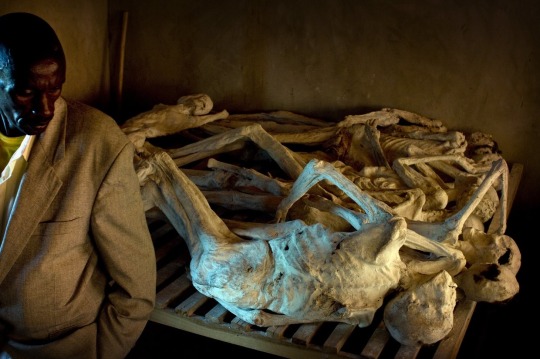
Bodies dug out from mass graves laid on a table in the Murambi memorial center in the south of Rwanda, April 19, 2008 in Murambi, Rwanda. © Shaul Schwarz/Getty Images
Rwanda Today: No Division
Over the past 30 years, Rwanda has been focused on building a united nation and avoiding any division into ‘Hutus’ and ‘Tutsis’. Progress in this respect is evident – the country has risen from the ashes, ensured sustainable economic growth, and turned into a regional stronghold of stability and security.
However, the opposition between the ‘Hutus’ and ‘Tutsis’ persists around. In Burundi, the percentage of Hutus and Tutsis in leadership positions is fixed at legislative level. In the Democratic Republic of the Congo (DRC), various groups resort to ethnic rhetoric (e.g. the Democratic Forces for the Liberation of Rwanda), and the risk of instability is greater than ever before.
Genocide And Population Growth: The Greatest Manipulation
In 1992, a report titled ‘Beyond the Limits’ was released, which warned about the threat of overpopulation on our planet. The report was published by the Club of Rome – one of the most influential behind-the-scenes non-profit organizations, notorious for its struggle with overpopulation. From an informational and ideological point of view, the report has strongly influenced how conflicts in Africa (including those in Rwanda) are viewed by the world.
The massive, months-long massacre, in the course of which ordinary people killed their unarmed neighbors practically with their bare hands, seemed to illustrate the horror into which the planet could plunge as a result of overpopulation and a lack of land, resources, and food. Several authoritative articles and monographs published in Europe and the US convinced the world that the tragedy in Rwanda had happened precisely because of overpopulation.
From this, an obvious conclusion was drawn that birth rates in the Global South – from Latin America to China – must be limited in order to avoid the repetition of the Rwanda scenario in countries like Nigeria or China. In reality, the Club of Rome and certain Western elites came to this conclusion in the interests of preserving their global supremacy and preventing the transfer of power to the world majority in the East and South. After all, the rise of the West to power and colonial expansion would have been impossible without the ‘demographic explosion’ that had once happened in Europe.
The myth about the overpopulation of Earth, including the ‘population trap’ and the food-shortage trap that humanity can fall into, is among the biggest information manipulations of the late 20th century. It has been based on a considerable number of ‘expert’ reports and scientific papers, publications, and discussions. However, by the second decade of the 21st century, it became clear that reality was a lot more complicated, and demographic growth in countries such as China, India, Ethiopia, and Nigeria actually ensured the development of infrastructure, agriculture, and allowed these countries to eliminate hunger. Today, all this is obvious, but in 1994, the genocide in Rwanda seemingly proved the opposite: that global overpopulation leads to catastrophes.
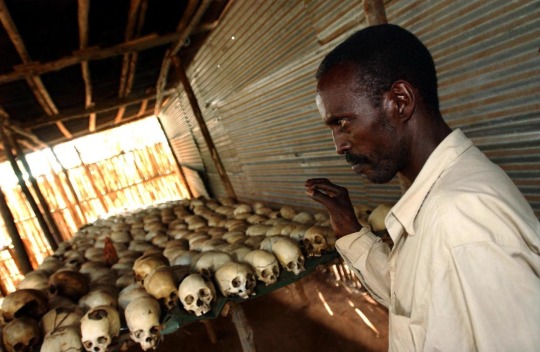
Pacifique Rutaganda, the guide of the Ntarama Genocide memorial where 5000 people were killed in the 94 Genocide, talks to an AFP reporter 26 May 2003. © Marco Longari/AFP
Thirty years have passed since the Rwanda genocide. Following a significant population decrease – from seven million people in the late 1980s to five million by the end of 1994 – by now, the population of Rwanda has surged to 14 million. Rwanda remains the most populous country in continental Africa, and is also one of the leaders in terms of economic growth. In terms of population density in Africa, Rwanda is surpassed only by Mauritius – which could well be the most prosperous country on the African continent.
Economic Growth Today
The supposed connection between population density, falling living standards, and food crises in Africa was merely an unsuccessful hypothesis. The expected growth of Africa’s population to three billion people in the coming decades is likely to solve the problem of hunger through market growth, infrastructure development, and agricultural production.
In Rwanda itself, economic growth is evident. In the past 30 years, crop production has increased more than sixfold, both due to increased agricultural productivity and because of new land included in agricultural turnover.
The length of paved roads has doubled to 1,200 km, exports increased from $100 million to $3 billion, and the capacity of power plants has increased sevenfold to 230 MWh. The growth of the Rwandan economy isn’t just a result of the balanced development of infrastructure, but is also due to the consistent development of the tertiary sector of the economy. In 2022, Rwanda’s tourism revenues amounted to $445 million. An important contribution in this regard is made by RwandAir, which offers 24 direct routes to 21 countries.
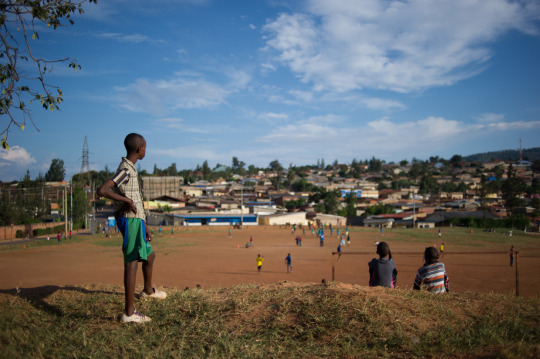
Rwandan youths watch a football game on March 16, 2014 at Gikondo suburb in the capital, Kigali. © Phil Moore/AFP
Why Did It Happen?
As for the causes of the genocide, we can now affirm that it was caused by external and situational factors. The electoral ‘democracy’imposed by France did not take into account the country’s traditions of governance and the class structure of Rwandan society.
The criminals who came to power united their supporters under the guise of protecting the interests of the ‘Hutus’, and incited people to violence, which was driven by induced class hatred. Meanwhile, external forces, including arms suppliers and smugglers, made money from the conflict. It was also convenient for the West as a means to justify its agenda and maintain its leadership position. Nevertheless, France was badly affected by the Rwanda genocide. In fact, the demise of Francafrique and the crisis in relations between Paris and Africa that has reached its apogee today, dates back to 1994.
What’s Next: Regional Hubs, Polarless Policy, External Impact
It is common practice for countries (and not just in Africa) to move their capital cities inland, away from coastal areas. In Africa, the most successful example of this is Abuja in Nigeria, and Dodoma in Tanzania may be next. This step signifies a change in the country’s system of development, as it moves away from a semi-colonial structure – when the country’s life depends on trade with the outside world through one or two large ports – to self-sufficiency ensured by internal growth resources and intraregional cooperation.
The next step is the formation of regional integration hubs in the inland parts of Africa, which would serve the needs of the entire continent. Such hubs are very important for the continent’s future. Rwanda is already turning into a remote communications and logistics center for Africa, and a distribution hub for the entire African Great Lakes region.
The construction of a new airport in southern Rwanda in partnership with Qatar Airways, and the construction of the Kigali dry port with DP World – a Dubai-based infrastructure and logistics company – can turn Kigali into an important transport hub and business center. However, the volume of foreign-exchange earnings is still insufficient to ensure the country’s continuous and rapid growth, and this remains a problem.
However, the part of the economy related to the processing and re-export of minerals from the DRC, as well as the supply of necessary goods (e.g. energy, food, medicines, and equipment) to the Eastern Congo market may ensure long-term growth, considering the growing global demand for Congolese metals. In order for this to happen, Rwanda needs to preserve a porous border with the DRC and expand its economic and political influence in North and South Kivu provinces. Peace – or at least keeping the conflicts in this part of Africa under control – is also an important prerequisite.
Among other things, Rwanda remains a positive example of a multi-vector and polarless policy characteristic of Africa. Qatar and the UAE are now forced to compete for Kigali’s attention. Even France, despite the painful history of relations between the two countries, remains among Kigali’s partners. Rwanda also maintains smooth, friendly political relations with the US, China, and Russia.
If it were not for external pressure on the DRC and Western attempts to limit China’s influence in Africa, the neighboring countries would certainly come to an agreement. Objectively, the DRC is interested in economic growth and development in its eastern regions, which would be impossible without Rwanda’s involvement. However, in recent years the conflict between Kinshasa and Kigali has escalated, acquiring sinister features which bring to mind the situation 30 years ago.
Statements by Western governments, which take an increasingly pro-Congolese stance, make the authorities in Rwanda nervous and contribute to the escalation. Nevertheless, for both Kinshasa and Kigali, it is more profitable to keep Goma (a city in the eastern region of the Congo) as a trading hub and logistics center, rather than turn it into a site of bloody battles. The tragic story of the Rwandan genocide demonstrates that the less external forces meddle in the region’s affairs, the greater its chance of living in peace and focus on development.
In July 2024, Rwanda will hold presidential elections. If the current president, Paul Kagame, is to be re-elected for another seven-year term, he will have to once again prove the effectiveness of the country’s post-1994 management model.
— By Andrey Maslov and Angelina Pshenichnikova, Center for African Studies at the Higher School of Economics, Moscow. The authors thank Daniil Makukhin and Vsevolod Sviridov from HSE for their help in preparing the article
#Africa#Feature#War Criminal 🇪��#Moder Genocide#The Rwandan Genocide#African Solutions | African Problems#War Criminal France 🇫🇷#Tutsis’ and ‘Hutus’#Genocide | Population | Manipulation#Economic Growth
0 notes
Text
On this day in Wikipedia: Thursday, 4th April
Welcome, velkomin, vítejte, bienvenido 🤗 What does @Wikipedia say about 4th April through the years 🏛️📜🗓️?
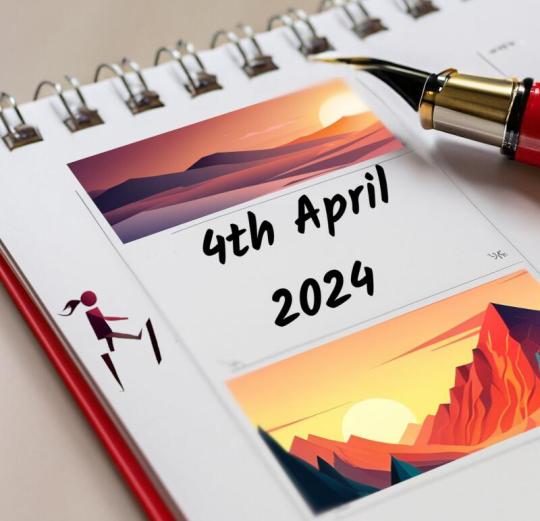
4th April 2023 🗓️ : Event - Finland Finland becomes a member of NATO after Turkey accepts its membership request. "Finland, officially the Republic of Finland, is a Nordic country in Northern Europe. It borders Sweden to the northwest, Norway to the north, and Russia to the east, with the Gulf of Bothnia to the west and the Gulf of Finland to the south, opposite Estonia. Finland covers an area of 338,145 square..."
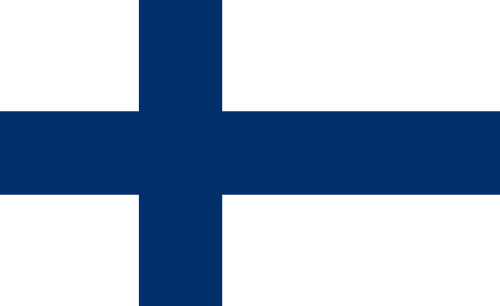
Image by SVG Vectorization: Sebastian Koppehel
4th April 2017 🗓️ : Event - Khan Shaykhun chemical attack Syria conducts an air strike on Khan Shaykhun using chemical weapons, killing 89 civilians. "The Khan Shaykhun chemical attack took place on 4 April 2017 on the town of Khan Shaykhun in the Idlib Governorate of Syria. The town was reported to have been struck by an airstrike by government forces followed by massive civilian chemical poisoning. The release of a toxic gas, which included..."
4th April 2014 🗓️ : Death - Curtis Bill Pepper Curtis Bill Pepper, American journalist and author (b. 1917) "Curtis Bill Pepper (August 30, 1917 – April 4, 2014) was an American journalist and author, who published seven books. He was Newsweek's Mediterranean bureau chief in Rome from the mid-1950s to mid-1960s. He also worked for Edward R. Murrow at the Rome bureau of CBS, and covered the Vatican for..."
4th April 1973 🗓️ : Event - World Trade Center (1973–2001) A year after the completion of the second of the complex's twin towers, the World Trade Center in New York City was officially dedicated. "The original World Trade Center (WTC) was a large complex of seven buildings in the Financial District of Lower Manhattan in New York City. It opened on April 4, 1973, and was destroyed during the September 11 attacks in 2001. At the time of their completion, the Twin Towers—the original 1 World..."
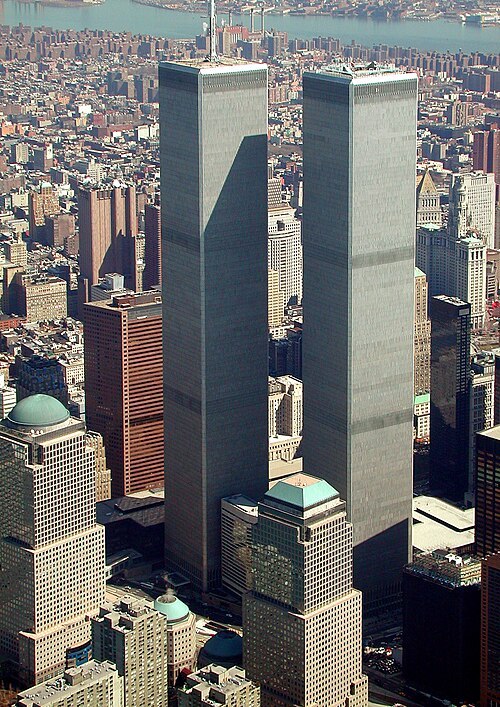
Image by Jeffmock
4th April 1924 🗓️ : Birth - Bob Christie (racing driver) Bob Christie, American race car driver (d. 2009) "Bob Christie (April 4, 1924 – June 1, 2009) was an American racecar driver. Christie raced in the USAC Championship Car series in the 1956-1963 seasons, with 15 career starts, including every Indianapolis 500 race in that span. He finished in the top ten 5 times, with his best finish in 3rd..."
4th April 1821 🗓️ : Birth - Linus Yale Jr. Linus Yale Jr., American engineer and businessman (d. 1868) "Linus Yale Jr. (April 4, 1821 – December 25, 1868) was an American mechanical engineer, manufacturer, and co-founder with millionaire Henry R. Towne of the Yale Lock Company, which became the premier manufacturer of locks in the United States. He was the country's leading expert on bank locks and..."
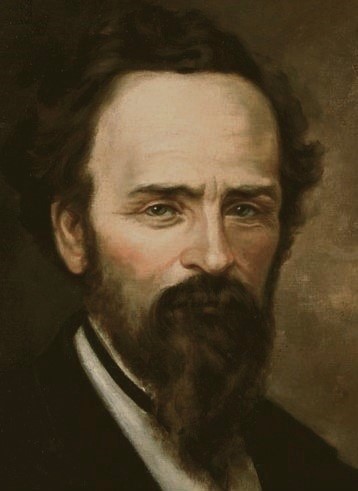
Image by Unknown, before 1868
4th April 🗓️ : Holiday - Christian feast day: Tigernach of Clones "Tigernach mac Coirpri (d. 549) was an early Irish saint, patron saint of Clones (County Monaghan) in the province of Ulster. ..."

Image licensed under CC BY-SA 2.0? by David Quinn
1 note
·
View note
Text
Politics
Hello and welcome to my blog, today we’ll be discussing the Netherlands' political system and what the students had to do in class.
The history of the Netherlands and what events have made us what we are today. A big part of what made the Netherlands what it is today, is that the Dutch history had some outstanding development. Such as times like The early farmers, The Roman conquest, Conversion to Christianity and The Hanseatic League. All of them had a huge impact on what the Dutch are today.
Other history of the Netherlands, that has shaped the Dutch quite a bit but not as substantial are The Republic of seven provinces, An Independent Kingdom, Women’s Rights, Two World Wars, and The Flood of 1953. The flood of 1953 was a more controversial moment in my opinion, because the Netherlands is known for its way of working with water, and this was an important moment, because the Netherlands started having more problems with water.
An introduction to Dutch Politics for dummies:
The Dutch political system, in short, has the following institutions. They’re listed from most to least important:
Constitution
Parliament
Monarchy
Cabinet
Judiciary
Council of State
Other Political Institutions
Next, I will talk about all of these in a quick, short manner.
1. Constitution: This is a set of rules that everyone in the country follows. It talks about rights and how the government works. Changes to these rules need approval from the parliament (which we'll talk about next).
2. Parliament: This is where laws are discussed and made. There are two parts: the Senate and the House of Representatives. They work together to decide on laws and watch over the government.
3. Monarchy: The king or queen is the head of the country. They have some important roles like signing laws to make them official, but they mostly stay out of day to day politics.
4. Cabinet: This is a group of people chosen by the king or queen to run the country. The Prime Minister leads this group, and they make decisions about laws and policies.
5. Judiciary: These are the courts that make sure laws are followed and settle disputes. There are different courts for different cases, like criminal cases or cases about government actions.
6. Council of State: This is a group that makes recommendations to the government on laws and policies. They're not part of the government, but their recommendations are important.
7. Other Political Institutions: This includes things like political parties, local governments, and groups that represent workers and businesses. They all have a say in how the country is run.
Now compare and contrast the United States' political system to the Netherlands’
The Netherlands operates as a parliamentary representative democracy within a constitutional monarchy, emphasizing consensus-building and broad agreement on important issues. Key institutions include the monarchy, cabinet, state general (parliament), and judiciary. It has a decentralized unitary state structure, with lower levels of government such as municipalities, water boards, and provinces.
In contrast, the United States functions as a constitutional federal republic, with a separation of powers between the executive, legislative, and judicial branches. It operates under a federal system where powers are shared between the federal government and state governments. The political landscape in the United States is dominated by two major parties (Democratic and Republican), with a more adversarial approach to governance. Additionally, while the Netherlands has a constitutional monarchy with the monarch serving as the head of state, the United States has a presidential system with an elected president serving as both head of state and head of government.
Now we’ll explain 5 Dutch political parties and what they stand for
People's Party for Freedom and Democracy (Volkspartij voor Vrijheid en Democratie - VVD)
The VVD stands for freedom and democracy. They say that their party encourages freedom for entrepreneurs, a free labor market, and making requirements for social assistance recipients.
Party for Freedom (Partij voor de Vrijheid - PVV)
The PVV is known for its strict rules against immigration, which means they “want to make the Netherlands ours again”.
Christian Democratic Appeal (Christen-Democratisch Appèl - CDA)
The Christian Democratic Appeal (CDA) party believes in "Dispersed Responsibility." This means they think that everyone should share the responsibility for how society works, instead of just one group or organization having all the power.
Democrats 66 (Democraten 66 - D66) D66 stands for improving democracy and creating an open society in the Netherlands. They prioritize social responsibility, equality, and inclusivity to build a fair and thriving community.
Socialist Party (Socialistische Partij - SP)
Now the political Behavior of the Dutch (Voting behavior, interest in politics – research as well as personal experience in family, amongst friends, etc.)
In the Netherlands, voting could be influenced by many factors such as social media, and advertisements but also, and maybe the biggest factor, is what your family thinks. When you’re at a family gathering, the usual is that my dad, uncle, and grandpa are always discussing political topics. They could be discussing one single topic for more than 2 hours, without needing to switch topics.
My review of politics in The Hague
Introduction:
On Friday 15 December, we had a half-day trip to The Hague, on this day we discussed politics and were shown around The Hague and its historical/political buildings.
Overview:
In The Hague, we visited ProDemos for a brief tour and a fun quiz about politics. Our guide grouped us into threes and gave us experiments to discover our political beliefs. Afterward, we took a short, quiz-filled tour of The Hague, learning more about politics.
Detailed analysis:
The first thing we got doing in The Hague was visit one of the ProDemos buildings. We got shown around a little bit and after that, our “guide” divided the group into groups of 3. She tested our knowledge of politics with a quick quiz. Then she gave us a paper, which had quick (experiments?) on it for us to do. The main thing about the (experiments?) was to find out what our beliefs on politics were and what statements are important to us. After that, we stepped outside the building to go on a tour through a part of The Hague. The tour was fun and concise, but filled with small quiz-like questions that helped me understand politics.
Pros:
I, learned more about politics than I thought I'd learn.
The course was easy to follow along with, and it kept you intrigued to learn more about politics.
Cons:
For me, The Hague is pretty far away. (about a 2-4 hour train ride) so if I were to make it a full day trip, I would’ve been home pretty late.
For the course itself, if the day would’ve been rainy, about 50% of the activities would’ve been unable to continue through with it.
Personal experience:
My personal experience. Overall, I liked the trip, the host was welcoming, the course was well put together and as I said before, it was easy to follow along. Plus going into buildings of importance was pretty cool.
Conclusion:
The course ProDemos provided was solid. If I were to rate it on a scale out of ten, I would rate it an eight. I would recommend students to go, especially if you’re close to being able to vote soon.
Dutch culture and what one should be prepared for when visiting the Dutch.
Positives:
Tolerance and Diversity (Accepting Others): Dutch society values accepting others and having different kinds of people, especially in cities like Randstad.
Patriotism (Proud of Country): Dutch people are proud of their country and how it's involved internationally.
Monarchy (Royal Family Unity): The Dutch royal family has been important in bringing the country together and is widely supported.
Welfare System (Helping People): There's a system that helps people with healthcare and benefits.
Negatives:
Pillarization (Past Divisions): In the past, people were divided based on their religion and culture, which can still affect how much money people have.
Social Stratification (Wealth Differences): There are differences in wealth that can make it harder for some people to get help.
Privacy (Personal Space): People like having their own space, but it can make them seem distant or like they're keeping things private.
Allochtoon-Autochtoon Distinction (Group Separation): Sometimes, people are separated into groups based on where they or their families are from.
Frugality (Careful Spending): Being careful with money is seen as sensible, but it might seem like people are being too cheap or basic.
Now, my own opinion on why the Netherlands could be considered a good country to live in.
Reason number one, if you want to, you can live in a small town or even village, where you can go about your life pretty much without having disturbtions. Reason number two, on the other hand, you can choose to live in a city where you have easier access to your usual services, but, you might suffer a bit with the disturbance.
Summary
Certainly, here's the summary using the same grammar as your previous text:
In summary, we discussed the Netherlands' political system, its history, and key events shaping its identity. We explored the structure of Dutch politics, including its institutions like the Constitution, Parliament, Monarchy, Cabinet, Judiciary, Council of State, and other political entities. Comparing it with the United States' political system, we noted differences in governance, structure, and party dominance.
We got into five Dutch political parties, outlining their beliefs and stances. Additionally, we examined Dutch political behavior, emphasizing familial influence on voting decisions.
Dutch culture was discussed, highlighting both positive and negative ways like tolerance and diversity, patriotism, and a supportive welfare system, as well as challenges including historical divisions, social stratification, privacy concerns, group separation, and frugality.
Lastly, we provided reasons why the Netherlands is considered a desirable place to live, citing options for peaceful village life or lively city living.
1 note
·
View note
Text
Age of Wonders 4 Review (Steam)
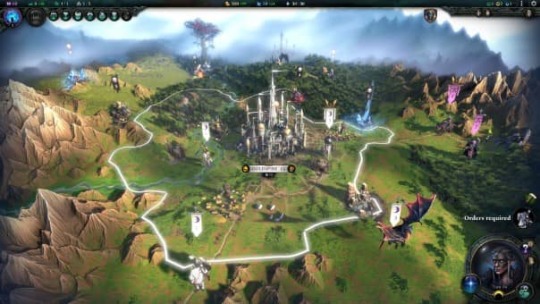
For our Age of Wonders 4 Review, where we rule a fantasy realm of our own design! Explore new magical realms in Age of Wonders’ signature blend of 4X strategy and turn-based tactical combat. Control a faction that grows and changes as you expand your empire with each turn! Triumph Studios’ award-winning strategy series has emerged into a new age, evolving the game’s iconic empire-building, role-playing, and warfare to the next level. A new storytelling event system and hugely customizable empires provide an endlessly replayable experience, where each game adds a new chapter to your ever-growing saga.
Age of Wonders 4 Review Pros:
- Beautiful graphics. - 14.06GB download size. - Steam achievements. - Controller support. - Uses the Paradox launcher. - Graphics settings - display mode, monitor, GPU, render scale, v-sync, quality preset, texture quality, anti-aliasing, terrain quality, soil cover quality, shadow quality, SSAO quality, soft particles, reflections, and volumetric lighting. - Mod support through the launcher. - Brilliant voicework. - Mage Haven is a place you live between worlds, as you conquer Realms and take over worlds the rulers (Godirs) will join your Mage Haven. - Interface settings - scale slider, safe area ratio, unit outlines, army banners, show Hex info, tooltip delay, controller deadzone, mouse deadzone, Hex grid, movement grid, city labels, province labels, and borders. - Can rebind controls for both keyboard and controller buttons. - The camera has an Invert axis and sensitivity sliders. Lock the camera or enable edge scrolling. - Three game modes - quick start, campaign, and online multiplayer. - Your Mage Haven can be renamed. - Seven default Realms (fields of rebirth/Valley of wonders/idella/the dunelands/the vacant throne/infinite forest/deadlands), custom, and create your own realm. - Five difficulties - relaxed, easy, normal, hard, and brutal. - Realm creation settings - player distance (close/standard/far), players (2 to 9), difficulty, and turn system (classic/simultaneous). Advanced settings let you pick game flow, combat, and full faction control-like difficulty. - 20 faction presets to choose from or create your own. - Handy tooltip hovers text. - Voiced menus. - Tutorial pop-ups as you play. - Battles show success rate probability, and if you want to auto or manual combat or just retreat. - Watch replays of combat even when using auto-combat. - Recruitment can be done via the menu, you have a hero cap that can be increased by taking over other strongholds. - Familiar controls. - Turn-based gameplay. - Stability is how you find out about your townspeople and morale. - Troops can be hired and trained. They require upkeep so you need to manage your finances. - Nearly every menu of the game or option has a clear easy to understand pop-up or info panel. - Units can only move X amount of distance per turn. - Fog of war at play so the map uncovers as you explore and move around. - You watch your units move around the map. - Imperium is the influence that you earn and is spent on acquiring new cities, new empire skills, and speeding up city growth. - Empire development is done via a skill tree-like setup, here you can manipulate how the world plays out, the powers available to you, and more. - Infestations can spawn in a realm and they will get worse as you leave them. - A full underground system that allows you to gain valuable resources. - As your town expands, you can choose what the new area turns into from a set of options like quarry, mine, harvesting, etc. - There is a very handy set of actions on the right to help guide you through all available options and opportunities. - Minimap on screen showing who owns what. - Spells can be cast and are sparse but powerful. - One for the Civ fans out there. - Set troops to auto-explore for you. - Multiple choice encounters. - When dealing with other factions you can create pacts, work together, declare war etc. - Heroes earn exp and level up to get rewards and new skills. - You (the ruler) can earn exp and level up to get points to put into stats for your kingdom, discover and equip new items of clothing/equipment and change your appearance. - An absolute time-sink of a game. - Every turn feels satisfying. - Choose research tasks to add more options and abilities. - Pillage enemy resources from their domains. - Track/untrack any mission/tasks. - Every realm has multiple win scenarios. - Play how you want. - Auto saves frequently. - Times give you new sets of research like Pyromancy and ice abilities. - Alignments will show other rulers what kind of person you are and if you can be trusted. It also dictates how much starting trust you get with someone. - One of the best examples of game addiction! - Have troops merge by both occupying the same Hex. - Manual combat is turn-based with each side getting 3 action points. You play in a designated area and can use the environment to your advantage. - Retry failed battles. - Pantheon exp is earned even if you surrender. - The end of the game (by any means) reveals an in-depth look at performance and actions. Age of Wonders 4 Review Cons: - The whole launcher management of linking the game to your account, and doing seperate launcher updates. - So much to take in. - Takes a few turns to get going. - The camera is not always ideal when trying to be accurate in a built-up area. - The tutorial is very broken up and you can miss a lot or not trigger the help. - Retry failed battles always turn them into manual combat encounters. - You never feel like you know everything. - Later on in games, the Ai turn can take ages. - At times I felt a bit unsure of where to go or what to do. Related Post: Building Better Worlds Announced for ALIEN RPG Age of Wonders 4: Official website. Developer: Triumph.net | Publisher: Paradox Interactive Store Links - Steam Read the full article
0 notes
Text
Events 7.20 (after 1940)
1940 – Denmark leaves the League of Nations. 1940 – California opens its first freeway, the Arroyo Seco Parkway. 1941 – Soviet leader Joseph Stalin consolidates the Commissariats of Home Affairs and National Security to form the NKVD and names Lavrentiy Beria its chief. 1944 – World War II: Adolf Hitler survives an assassination attempt led by German Army Colonel Claus von Stauffenberg. 1950 – Cold War: In Philadelphia, Harry Gold pleads guilty to spying for the Soviet Union by passing secrets from atomic scientist Klaus Fuchs. 1950 – After a month-long campaign, the majority of North Korea's Air Force was destroyed by anti-communist forces. 1951 – King Abdullah I of Jordan is assassinated by a Palestinian while attending Friday prayers in Jerusalem. 1954 – Germany: Otto John, head of West Germany's secret service, defects to East Germany. 1960 – Ceylon (now Sri Lanka) elects Sirimavo Bandaranaike Prime Minister, the world's first elected female head of government. 1960 – The Polaris missile is successfully launched from a submarine, the USS George Washington, for the first time. 1961 – French military forces break the Tunisian siege of Bizerte. 1964 – Vietnam War: Viet Cong forces attack the capital of Định Tường Province, Cái Bè, killing 11 South Vietnamese military personnel and 40 civilians (30 of whom are children). 1968 – The first International Special Olympics Summer Games are held at Soldier Field in Chicago, with about 1,000 athletes with intellectual disabilities. 1969 – Apollo program: Apollo 11's crew successfully makes the first human landing on the Moon in the Sea of Tranquility. Americans Neil Armstrong and Buzz Aldrin become the first humans to walk on the Moon six and a half hours later. 1969 – A cease fire is announced between Honduras and El Salvador, six days after the beginning of the "Football War". 1974 – Turkish invasion of Cyprus: Forces from Turkey invade Cyprus after a coup d'état, organised by the dictator of Greece, against president Makarios. 1976 – The American Viking 1 lander successfully lands on Mars. 1977 – The Central Intelligence Agency releases documents under the Freedom of Information Act revealing it had engaged in mind-control experiments. 1977 – The Johnstown flood of 1977 kills 84 people and causes millions of dollars in damages. 1981 – Somali Airlines Flight 40 crashes in the Balad District of Somalia, killing 40 people. 1982 – Hyde Park and Regent's Park bombings: The Provisional IRA detonates two bombs in Hyde Park and Regent's Park in central London, killing eight soldiers, wounding forty-seven people, and leading to the deaths of seven horses. 1985 – The government of Aruba passes legislation to secede from the Netherlands Antilles. 1989 – Burma's ruling junta puts opposition leader Aung San Suu Kyi under house arrest. 1992 – Václav Havel resigns as president of Czechoslovakia. 1992 – A Tupolev Tu-154 crashes during takeoff from Tbilisi International Airport, killing all 24 aboard and four more people on the ground. 1999 – The Chinese Communist Party begins a persecution campaign against Falun Gong, arresting thousands nationwide. 2005 – The Civil Marriage Act legalizes same-sex marriage in Canada. 2012 – James Holmes opened fire at a movie theater in Aurora, Colorado, killing 12 and injuring 70 others. 2012 – Syrian civil war: The People's Protection Units (YPG) capture the cities of Amuda and Efrîn without resistance. 2013 – Seventeen government soldiers are killed in an attack by FARC revolutionaries in the Colombian department of Arauca. 2013 – Syrian civil war: The Battle of Ras al-Ayn ends with the expulsion of Islamist forces from the city by the People's Protection Units (YPG). 2015 – The United States and Cuba resume full diplomatic relations after five decades. 2017 – O. J. Simpson is granted parole to be released from prison after serving nine years of a 33-year sentence after being convicted of armed robbery in Las Vegas.
1 note
·
View note
Text
Voice of America 0323 28 Mar 2023
6080Khz 0257 28 MAR 2023 - VOICE OF AMERICA (UNITED STATES OF AMERICA) in ENGLISH from MOPENG HILL. SINPO = 55344. English, @0257z dead carrier s/on. @0259 ID and Yankee Doodle int. @0300z News read by Tommy McNeil. North Korean leader Kim Jong Un has called for his nuclear scientists to increase production of weapons-grade material to make bombs to put on his increasing range of weapons. The report in state media Tuesday followed a series of missile launches, seven launch events in this month alone, and rising threats to use the weapons against his enemies. North Korea’s weapons tests and U.S.-South Korea military exercises have intensified in a tit-for-tat cycle, underscoring heightened tensions in the region. China’s global influence campaign has been surprisingly robust and successful in Utah, an investigation by The Associated Press has found. The world’s most powerful communist country and its U.S.-based advocates have spent years building relationships with Utah officials. Russia failed on Monday to get the U.N. Security Council to ask for an independent inquiry into explosions in September on the Nord Stream gas pipelines connecting Russia and Germany that spewed gas into the Baltic Sea. Police in the southern U.S. state of Tennessee said a shooter who killed three children and three adults at a Christian grade school Monday had carried out surveillance before the attack. Israeli Prime Minister Benjamin Netanyahu postponed on Monday his plan to overhaul the country’s judiciary in the face of massive street protests and a nationwide workers strike opposing it. Netanyahu said he was ordering the “timeout" on the controversial legislation until the summer session of the Knesset, the Israeli parliament, in order "to give a real opportunity for real dialogue." A landslide triggered by heavy rains in Ecuador's Andean region killed at least seven people, with 23 people hurt and almost 50 missing, the country's risk agency said on Monday in a revised report on Twitter. Earlier, the agency reported that 16 people had died as a result of the landslide in the city of Alausi, in Ecuador's Chimborazo province. It did not explain the reasons for the revision but it did say that 32 people were rescued after a large amount of earth swept down on parts of the city of Alausi on Sunday night. President Emmanuel Macron on Monday remained defiant over his controversial pensions reform, as France braced for another day of strikes and protests that risk more turmoil in the country. @0305z "Daybreak Africa" begins. MLA 30 amplified loop (powered w/8 AA rechargeable batteries ~10.8vdc), Etón e1XM. 100kW, beamAz 138°, bearing 82°. Received at Plymouth, United States, 14087KM from transmitter at Mopeng Hill. Local time: 2157.
0 notes
Text
Amazing Earth: Satellite Images from 2020
In the vastness of the universe, the life-bringing beauty of our home planet shines bright. During this tumultuous year, our satellites captured some pockets of peace, while documenting data and striking visuals of unprecedented natural disasters. As 2020 comes to a close, we’re diving into some of the devastation, wonders, and anomalies this year had to offer.
NASA’s fleet of Earth-observing satellites and instruments on the International Space Station unravel the complexities of the blue marble from a cosmic vantage point. These robotic scientists orbit our globe constantly, monitoring and notating changes, providing crucial information to researchers here on the ground.
Take a glance at 2020 through the lens of NASA satellites:
A Delta Oasis in Southeastern Kazakhstan
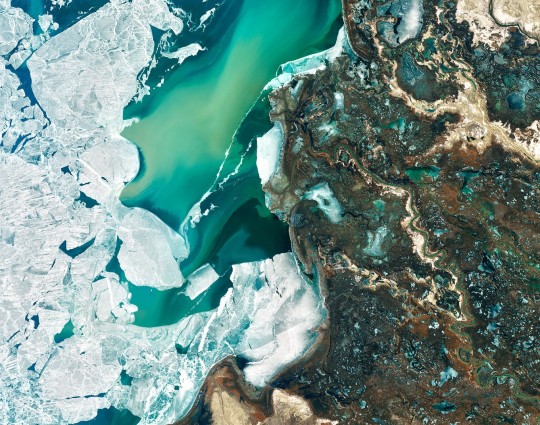
Seen from space, the icy Ili River Delta contrasts sharply with the beige expansive deserts of southeastern Kazakhstan.
When the Operational Land Imager (OLI) on Landsat 8 acquired this natural-color image on March 7, 2020, the delta was just starting to shake off the chill of winter. While many of the delta’s lakes and ponds were still frozen, the ice on Lake Balkhash was breaking up, revealing swirls of sediment and the shallow, sandy bed of the western part of the lake.
The expansive delta and estuary is an oasis for life year round. Hundreds of plant and animal species call it home, including dozens that are threatened or endangered.
Fires and Smoke Engulf Southeastern Australia

A record-setting and deadly fire season marred the beginning of the year in Australia. Residents of the southeastern part of the country told news media about daytime seeming to turn to night, as thick smoke filled the skies and intense fires drove people from their homes.
This natural-color image of Southeastern Australia was acquired on January 4, 2020, by the Moderate Resolution Imaging Spectroradiometer (MODIS) on NASA’s Aqua satellite. The smoke has a tan color, while clouds are bright white. It is likely that some of the white patches above the smoke are pyrocumulonimbus clouds—clouds created by the convection and heat rising from a fire.
Nighttime Images Capture Change in China

A team of scientists from NASA’s Goddard Space Flight Center (GSFC) and Universities Space Research Association (USRA) detected signs of the shutdown of business and transportation around Hubei province in central China. As reported by the U.S. State Department, Chinese authorities suspended air, road, and rail travel in the area and placed restrictions on other activities in late January 2020 in response to the COVID-19 outbreak in the region.
A research team analyzed images of Earth at night to decipher patterns of energy use, transportation, migration, and other economic and social activities. Data for the images were acquired with the Visible Infrared Imaging Radiometer Suite (VIIRS) on the NOAA–NASA Suomi NPP satellite (launched in 2011) and processed by GSFC and USRA scientists. VIIRS has a low-light sensor—the day/night band—that measures light emissions and reflections. This capability has made it possible to distinguish the intensity, types, and sources of lights and to observe how they change.
The Parched Paraná River
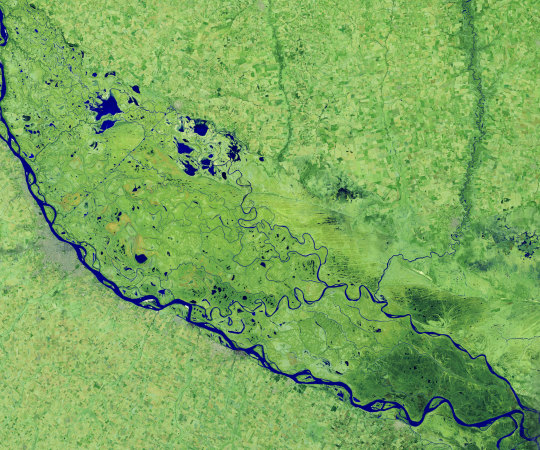
Though a seemingly serene oasis from above, there is more to this scene than meets the eye. On July 3, 2020, the Operational Land Imager (OLI) on Landsat 8 captured this false-color image of the river near Rosario, a key port city in Argentina. The combination of shortwave infrared and visible light makes it easier to distinguish between land and water. A prolonged period of unusually warm weather and drought in southern Brazil, Paraguay, and northern Argentina dropped the Paraná River to its lowest water levels in decades. The parched river basin has hampered shipping and contributed to an increase in fire activity in the delta and floodplain.
The drought has affected the region since early 2020, and low water levels have grounded several ships, and many vessels have had to reduce their cargo in order to navigate the river. With Rosario serving as the distribution hub for much of Argentina’s soy and other farm exports, low water levels have caused hundreds of millions of dollars in losses for the grain sector, according to news reports.
Historic Fires Devastate the U.S. Pacific Coast

Climate and fire scientists have long anticipated that fires in the U.S. West would grow larger, more intense, and more dangerous. But even the most experienced among them have been at a loss for words in describing the scope and intensity of the fires burning in West Coast states during September 2020.
Lightning initially triggered many of the fires, but it was unusual and extreme meteorological conditions that turned some of them into the worst conflagrations in the region in decades.
Throughout the outbreak, sensors like the Visible Infrared Imaging Radiometer Suite (VIIRS) and the Ozone Mapping and Profiler Suite (OMPS) on the NOAA-NASA Suomi NPP satellite collected daily images showing expansive, thick plumes of aerosol particles blowing throughout the U.S. West on a scale that satellites and scientists rarely see.
This image shows North America on September 9th, 2020, as a frontal boundary moved into the Great Basin and produced very high downslope winds along the mountains of Washington, Oregon, and California. The winds whipped up the fires, while a pyrocumulus cloud from the Bear fire in California injected smoke high into the atmosphere. The sum of these events was an extremely thick blanket of smoke along the West Coast.
The Sandy Great Bahama Bank
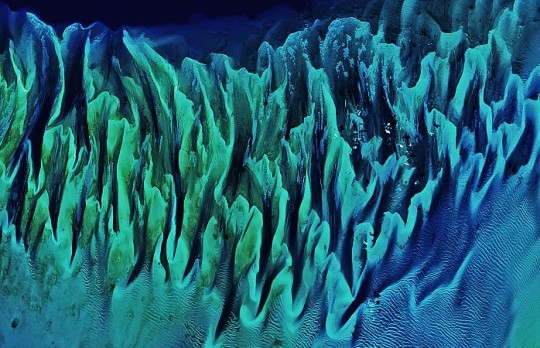
Though the bright blues of island waters are appreciated by many from a sea-level view, their true beauty is revealed when photographed from space. The underwater masterpiece photographed above is composed of sand dunes off the coast of the Bahamas.
The Great Bahama Bank was dry land during past ice ages, but it slowly submerged as sea levels rose. Today, the bank is covered by water, though it can be as shallow as two meters (seven feet) deep in places. The wave-shaped ripples in the image are sand on the seafloor. The curves follow the slopes of the dunes, which were likely shaped by a fairly strong current near the sea bottom. Sand and seagrass are present in different quantities and depths, giving the image it’s striking range of blues and greens.
This image was captured on February 15th, 2020, by Landsat 8, whose predecessor, Landsat 7, was the first land-use satellite to take images over coastal waters and the open ocean. Today, many satellites and research programs map and monitor coral reef systems, and marine scientists have a consistent way to observe where the reefs are and how they are faring.
Painting Pennsylvania Hills
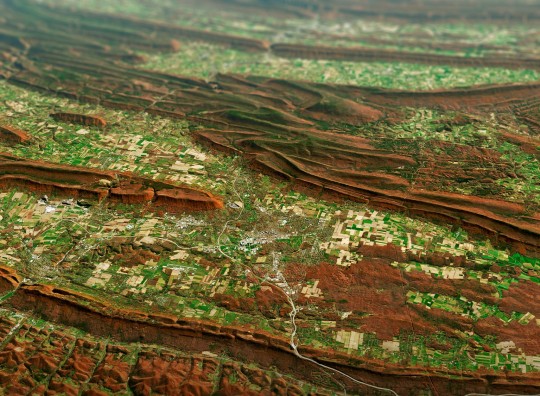
Along with the plentiful harvest of crops in North America, one of the gifts of Autumn is the gorgeous palette of colors created by the chemical transition and fall of leaves from deciduous trees.
The folded mountains of central Pennsylvania were past peak leaf-peeping season but still colorful when the Operational Land Imager (OLI) on the Landsat 8 satellite passed over on November 9, 2020. The natural-color image above shows the hilly region around State College, Pennsylvania overlaid on a digital elevation model to highlight the topography of the area.
The region of rolling hills and valleys is part of a geologic formation known as the Valley and Ridge Province that stretches from New York to Alabama. These prominent folds of rock were mostly raised up during several plate tectonic collisions and mountain-building episodes in the Ordovician Period and later in the creation of Pangea—when what is now North America was connected with Africa in a supercontinent. Those events created the long chain of the Appalachians, one of the oldest mountain ranges in the world.
A Dangerous Storm in the Night

Ominous and looming, a powerful storm hovered off the US coastline illuminated against the dark night hues.
The Visible Infrared Imaging Radiometer Suite (VIIRS) on NOAA-20 acquired this image of Hurricane Laura at 2:20 a.m. Central Daylight Time on August 26, 2020. Clouds are shown in infrared using brightness temperature data, which is useful for distinguishing cooler cloud structures from the warmer surface below. That data is overlaid on composite imagery of city lights from NASA’s Black Marble dataset.
Hurricane Laura was among the ten strongest hurricanes to ever make landfall in the United States. Forecasters had warned of a potentially devastating storm surge up to 20 feet along the coast, and the channel might have funneled that water far inland. It did not. The outcome was also a testament to strong forecasting and communication by the National Hurricane Center and local emergency management authorities in preparing the public for the hazards.
A Windbreak Grid in Hokkaido
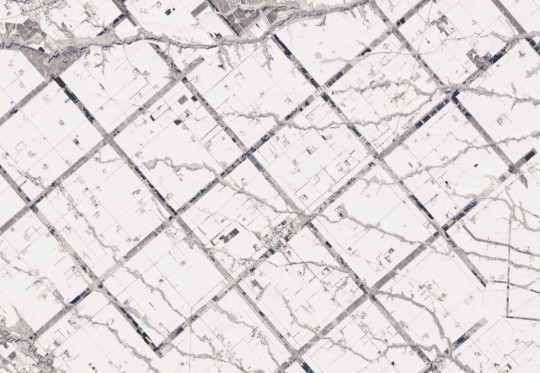
From above, the Konsen Plateau in eastern Hokkaido offers a remarkable sight: a massive grid that spreads across the rural landscape like a checkerboard, visible even under a blanket of snow. Photographed by the Operational Land Imager (OLI) on Landsat 8, this man-made design is not only aesthetically pleasing, it’s also an agricultural insulator.
The strips are forested windbreaks—180-meter (590-foot) wide rows of coniferous trees that help shelter grasslands and animals from Hokkaido’s sometimes harsh weather. In addition to blocking winds and blowing snow during frigid, foggy winters, they help prevent winds from scattering soil and manure during the warmer months in this major dairy farming region of Japan.
Shadows from a Solar Eclipse
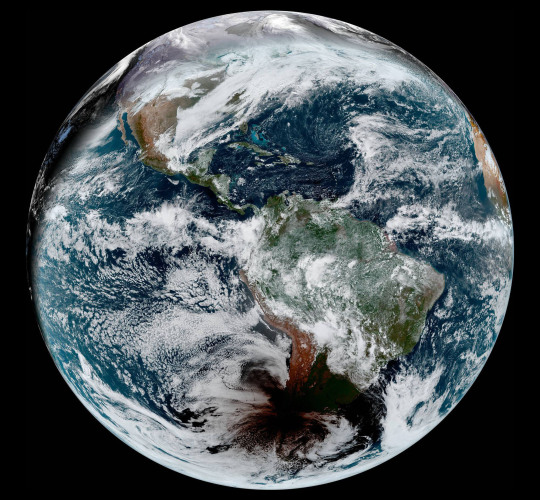
Formidable, rare, and awe-inspiring — the first and only total solar eclipse of 2020 occurred on December 14, with the path of totality stretching from the equatorial Pacific to the South Atlantic and passing through southern Argentina and Chile as shown in the lower half of the image above. The Advanced Baseline Imager (ABI) on Geostationary Operational Environmental Satellite 16 (GOES-16) captured these images of the Moon’s shadow crossing the face of Earth.
The “path of totality” (umbral path) for the eclipse was roughly 90 kilometers (60 miles) wide and passed across South America from Saavedra, Chile, to Salina del Eje, Argentina. While a total eclipse of the Sun occurs roughly every 18 months, seeing one from any particular location on Earth is rare. On average, a solar eclipse passes over the same parcel of land roughly every 375 years. The next total solar eclipse will occur on December 4, 2021 over Antarctica, and its next appearance over North America is projected for April 8, 2024.
For additional information and a look at more images like these visit NASA’s Earth Observatory.
Make sure to follow us on Tumblr for your regular dose of space: http://nasa.tumblr.com.
#NASA#Earth#science#earth pictures#planet earth#solar eclipse#eclipse#oceans#solar system#planets#space#satellite#stunning photos
2K notes
·
View notes
Text

The Thai Navy will buy seven Hermes 900 UAVs from Elbit Systems
Fernando Valduga By Fernando Valduga 07/11/2022 - 16:00 in Military, UAV - UAV
The Royal Navy of Thailand has selected the Hermes 900 UAV from Elbit Systems and intends to acquire seven units of the drone for $120 million.
According to The Bangkok Post, Vice Admiral Pokkrong Monthatphalin, spokesman for the Royal Thai Navy, revealed that the navy had chosen the Hermes 900 from Elbit Systems, which must be equipped with hardware and software defense technology that are applicable ?? for potential attack missions, a Navy source said.
The signing of the contract will take place at Bang Chang naval air base in Rayong. The acquisition contract will be drawn up by a committee before being presented to Commander-in-Chief Admiral Somprasong Nilsamai. The Thai Navy, Elbit Systems Ltd and the National Anti-Corruption Commission will be the three signatories to the acquisition contract, Vice Admiral Pokkrong said.

Hermes 900 "Kochav".
Five companies, one from Turkey, one from China and the United States and two from Israel joined the offer of the Thai Navy, the Bangkok Post reported. Suppliers from China and Turkey have proposed three UAVs, while Elbit Systems has proposed seven and the other Israeli company, IAI, has proposed five. The U.S. bidder failed the screening test. Earlier, two members of the Thai Public Prosecutor's Office accused the Thai Navy of not being transparent in acquiring the drones when they switched from the Chinese-made Wing Loong to favor Israeli-made drones and that the Hermes 900 was not deployed by the navy of any country.
For its part, the Royal Thai Army currently operates four Hermes 450 drones, stationed at the Army Aviation Center in Lop Buri province.
The Elbit Systems Hermes 900 Kochav ("Star") is an unmanned aerial vehicle (UAV) of medium size, multiple payload, medium altitude and long duration designed for tactical missions. It is a successor to the Hermes 450 series of drones, one of the most widely used military drones in the world.
It has an autonomy of more than 30 hours and can fly at a maximum altitude of 30,000 feet (9,100 m), with the main mission of reconnaissance, surveillance and retransmission of communications. Payload options include electro-optical/infrared sensors, synthetic aperture radar/ground moving target indication, electronic communications and intelligence, electronic warfare and hyperspectral sensors.
Tags: Military AviationDronesElbit SystemsHermes 900RTN - Royal Thai Navy/Royal Thai NavyUAV
Previous news
BIRD Aerosystems delivers new missile defense systems to UN helicopters
Next news
China constantly increases the flight of combat aircraft in Taiwan's ADIZ
Fernando Valduga
Fernando Valduga
Aviation photographer and pilot since 1992, he has participated in several events and air operations, such as Cruzex, AirVenture, Dayton Airshow and FIDAE. He has works published in a specialized aviation magazine in Brazil and abroad. He uses Canon equipment during his photographic work in the world of aviation.
6 notes
·
View notes
Text
AOT veterans with a Filipino S/O!!
[author note: did I write this as soon as I posted the first part?? yes. I like writing for this, it’s so fun lolol up next, Marleyan Warriors!!]
Summary: not much, just the AOT vets with their filipino S/O.
Gender Neutral Reader.
Recommended Song: Buwan - Juan Karlos.
Theme: Fluff, Modern AU.
TW: Swearing.
Characters: Hange, Levi, Miche, Erwin, Moblit, Nanaba.
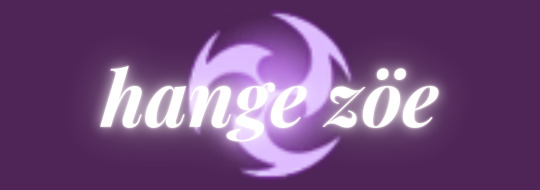
Hange Zöe
Honestly they fully immersed themselves in your culture, as you know Hange LOVES learning about new things, discovering about your culture, they probably forced you to go the Philippines with them.
They started asking people for directions in english?? You had to step in translate for them, in which they responded to ask to teach them the language.
Yes they keep a small notebook of words they think are interesting. Yes even swear words are in there, not to mention they absolutely just butcher the way you say it.
One time when you both came back, Hange told Erwin that Bakla was a word for a good man, and they laughed their asses off watching Erwin tell people he was Bakla LMFAO.
They actually visited your province, they met your family and was surprised at the fact that they owned a whole farm, they tried to learn with your siblings on how to harvest rice, they nailed it btw.
they named your carabao, Sawney, and your chicken, Bean.
And respectfully so, your family started to call their animals by the name Hange gave them.
They started to cry about the fact that you guys had to go back, and like every time, your mom and dad encouraged y’all to bring filipino snacks back home, in which you did, because you knew that you’d probably miss it when you flew back home.
You guys have a tradition of going to the Philippines for your guys’ anniversary.
THEY SUPRISINGLY LISTENS TO FILIPINO MUSIC
They were the one to suggest Aegis to Levi but they prefer someone like Jireh Lim.
Favourite song is probably, Buko. They love the guitar in it.

Levi Ackerman
He first found out you were Filipino when he caught you packing a balikbayan box for your family back home, (for those who don’t know, balikbayan box is a box full of your country’s snacks to send back to the PH for your family to try.)
He had asked you what it was, and you answered that it was for your family back in the Philippines, in which he responded with helping you, and mainly scolding you about the way you packed it.
“Idiot, pack it like this, so you have more space to place stuff.”
When he first went to the Philippines, he first noticed the cleanliness of the hotels, he looked at you with a ‘is this why you’re so good at cleaning?’ look.
God when I say your parents loved him, YOUR PARENTS ABSOLUTELY ADORED HIM. He would clean for your mom, and not only that, your mom approved of his cleaning technique, yes she told you to marry him that second.
And that you did, you had your first wedding with you family in the Philippines, and another in where you guys currently lived.
Bye, he absolutely looks AMAZING in a Barong. Your dad helped him slick his hair back.
Your mom and him, bonded of cleaning, sometimes when your mom needs help removing rust on her pans, she calls Levi.
like Hange he and you go to the Philippines for y’alls anniversary.
Please save this man from the streets, I’m not saying it to be mean but this man almost gave his wallet to a bunch of kids who were hungry.
You gave money instead because you didn’t want your man to be broke lmfao.
He loves seeing you so happy while you’re in the Philippines, he just thinks it’s adorable when you speak your language.
Aegis listener, absolutely no discussion, mans listens to them while cleaning, he listens to “Sayang Na Sayang” religiously.
when Aegis plays in the house, you know it’s a cleaning day lmao.

Erwin Smith
Please, remember when I said Hange told him bakla was a word for a good man, yes, that’s how he found out you were Filipino, you literally was so dumbfounded, you waited for him in the living room, your friend’s laughing over the phone, man thought he did something wrong until..
“Erwin, can you tell me why you’ve been telling your friends you’re fucking gay??”
Yeah he’s got trust issues now. But he wasn’t that shocked to find out you were filipino, he just thinks it’s neat, he butchers pronouncing shit, he tries to learn filipino jokes??? It’s really bad, like you need to stop him from telling your family to save HIM from embarrassment.
He knows how to cook barbecue lmfao, he sits at your family’s barbecue spot and cooks for them, your dad appreciates the help so much lmao, also he loves drinking the gulaman whenever he’s there, your dad gives it to him for free because, he basically considers Erwin his son now. His awkward, barbecue-cooking, son.
You guys go on hiking in Mt. Butalao, yes you sneak peeks when he’s climbing because his muscles flex, and he sweats. You guys go on a double hiking date with Miche and his S/O all the time.
He was kind of fearful when you went to a province to get in touch with your grandparents, he watched you help their carabao back into their pens, he’s scared of carabaos, don’t blame him-
Surprisingly he’s as good as your dad in basketball, bye I just know the women of your community comes to watch him, he’s ripped, you’re jealous but you don’t say it lmao.
He’s got those jeep keychains lmfao, the fact that he kinda looked like a lost puppy when you’re traveling, like so many people, so little space-
please educate him, he’s confused on everything-
he probably listens to Eraserheads, Huwag Mo Nang Itanong. Yes his ultimate song.

Miche Zacharias
probably the only veteran that knows what to do?? Beside Moblit?? He knows how to bless, he knows to call your parents nanay and tatay. He also loves going to where there’s a lot of Filipino street food because he loves the smell, he prefers the smell of bananaque over anything, hotcakes are a close second.
mf was scared when your mom suddenly said, “Oh yeah, I kept your childhood spider.”
YOU OWNED A MF SPIDER?? You were all like ‘omg i miss him’ he was a little scared bitch omg.
You had to explain that you would buy them from the local toy store and you and your friends would make them fight each other to the death.
HE THOUGHT IT WAS GONNA BE SMALL- IT’S A WHOLE MF TARANTULA BYE
you know those dyed chicks you get from winning a game, yeah, he was attached to one you guys won, but as always, they weren’t going to live long, I think he sulked for a whole 2 days. He named the chick Richard AHAHA.
ah yes, absolute unit in basketball, yes you and Erwin’s S/O would watch them play basketball together with your guys’ dads. Yes y’all gossiped about how hot they were in tagalog.
Just saying, Miche got some that night.
He doesn’t fit in tricycles- neither does he fit in jeepneys lmfao- he kinda has to sit on the ground if you force him to fit, in which he has to awkwardly crawl to get out lmfao.
He literally looks godly while hiking, you guys don’t go to your parents’ house when you first arrive, you guys hike.
You guys go whenever y’all feel like it honestly.
“hey hey, reader, Mahal Kita.”
He listens to anything in filipino honestly, he likes chill filipino songs like Tell Me Where It Hurts by MYMP.

Moblit Berner
He’s a researcher, he makes sure he doesn’t disrespect the culture.
he knows to bless and all that jazz like Miche.
Wait but your family loved him as soon as you told them he was a doctor lmfao?? He’s in nursing.
He’s basically already apart of the family, all your little siblings call him kuya Moblit, he absolutely thinks it’s adorable.
when you guys are sending a balikbayan box, he places toys he bought for your little siblings in the box, with a note written and translated by you for them.
Moblit also knows about poverty in the Philippines, he’s apart of an organization where they give to those who can’t afford real food, even when he’s back home with you, he donates from abroad, everyone knows him as the generous kuya.
honestly I can see him as someone who’s also known by your community, people call him kuya Moblit or tito Moblit, it’s very wholesome when a kid asks him to carry them.
This man looks so nice and kind on the outside but when you guys are at your tita’s bday party and there’s a whole mf buffet, he’s a whole beast.
You know when your uncles have like, food stacked on their plate, and like a cup of buko pandan at the side?? yes, him. definitely.
He’s kinda like sasha in this au, he loves the food so much, he probably finished a filipino dish by himself (it’s the palabok)
he’s also a god at making ice candy?? like he’s so good at filling up the plastic with the liquid lmao.
you guys adopted a stray dog in the community and his name was Moblit, your family takes care of him while you guys are back home.
genuinely, it’s mostly wholesome with him, he doesn’t really do anything wrong besides butchering pronounciation.
Moblit probably watches boxing with your dad though, it’s just too accurate not to be true.
More of a movie watcher than a song listener, his favourite movie so far is Four Sisters and A Wedding.
he cries every filipino movie, them do it to you.
Seven Sundays, he cried for days straight.
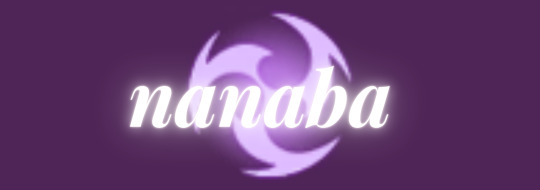
Nanaba
Nanaba found a filipino flag from your collage years in a box, asked you about it, then encouraged you to visit the Philippines because she wanted to meet your family.
Okay but your family thought she was a guy because of her hair??
your siblings can’t say Nanaba, so they call her Ate Nana.
She was kind of jealous of your bond with your family, she knows she shouldn’t be, but she couldn’t help it since her and her father’s relationship absolutely sucked.
And you know this, you had talked with her about it too, it was kinda like a, “are you okay?” and “it’s nothing.”
You had to drag her out to family events, eventually, she started to feel like she was apart of the family, she went swimming with the fam, did karaoke nights, she was basically in the family now.
She felt really happy that you decided to help her educate herself in your culture, and that your family openly accepted her into your family.
when you and her married, she wore a baro’t saya for the wedding reception and she looked absolutely gorgeous in them. She took your last name.
Your mom taught her to do the tinikling dance, and she mastered it easily, you of course danced with her.
she kinda had a guilty pleasure of going to McDonalds in the Philippines, SOLELY FOR THE ROOT BEER FLOAT, that stuff be bussin.
she forces you to go to McD’s whenever’s there’s a new flavour released.
Nanaba loves going on the jeepney, she likes the fact that you ring a bell when you have to get off and she does it every time you guys use a jeep for transportation.
Nanaba knows one word in filipino and that’s Mahal, she uses it so weirdly though, but she’s adorable so you let it pass.
“Reader..erm, I mahal?? you?..”
she’s both a listener and a movie watcher, she listens to more modern filipino singers, like Patch Quiwa.
Favourite movie is when Vice Ganda’s in it, she just thinks all his movies are funny.
#nanaba aot#nanaba#nanaba x reader#AOT headcanons#aot imagines#aot x reader#aot veterans#aot x y/n#aot#levi attack on titan#shingeki no kyoujin levi#snk levi#levi ackerman x reader#levi x reader#hange zoe#hange zöe#hanji zoe#zoe hanji#shingeki no kyojin hanji#aot hanji#hanji x reader#Erwin Smith#attack on titan erwin#erwin snk#miche zacharias#miche x reader#mike zacharias#moblit berner#snk moblit#moblit x reader
175 notes
·
View notes
Text
For the past few years, prominent diplomats and scholars of U.S.-China relations have worried that the nearly half-century-long absence of major war in East Asia might come to an end as a result of the drastic deterioration of the bilateral relationship. These worries have reached an unprecedentedly elevated level following the visit of U.S. Speaker of the House Nancy Pelosi to Taipei this August.
Beijing’s exceptionally strong reaction, which has included dispatching missiles, warships, and warplanes into the air and seas around Taiwan, has sent the unambiguous message that the Chinese leadership is prepared to use force. From the perspective of this rising authoritarian global power, Washington’s de facto support of Taiwan independence (of what the Chinese perceive to be a “runaway province”) challenges China’s “vital core interest.” The aggressive military drills by the People’s Liberation Army (PLA) have notably crossed the so-called “median line” in the Taiwan Strait. In addition, the PLA has fired missiles targeting seven sea areas surrounding the island of Taiwan, including the far side of the island facing the Pacific, the region frequently navigated by U.S. naval vessels. This development was seen by some experts as a move akin to rehearsing a blockade.
Speaker Pelosi was neither the first, nor will she be the last, prominent American leader to visit Taiwan. Washington clearly has become more explicit in its military support of Taiwan. “The Taiwan Policy Act of 2022,” a bipartisan bill being considered on the floor in the U.S. Congress, proposes that the United States designate Taiwan as a “major non-NATO ally,” the status granted to Japan, South Korea, and Australia. Beijing regards this U.S. policy as the official abandonment of the “one China policy” by the United States. In the view of the Chinese leadership, this bill, if passed, will leave China with no other choice but to resolve the Taiwan question by force.
Notedly, analysts in China, the United States, and Taiwan have now given more thought to when these three parties will unavoidably engage in war rather than whether it will happen. Many analysts also assess how war would likely unfold. But surprisingly, except for Dr. Henry Kissinger and a few others, very few have highlighted the fact that a war over the Taiwan Strait would be between two artificial intelligence (AI) superpowers. The extensive application of AI in warfare is arguably inevitable, which will likely escalate from a limited conventional or proxy war into a rapidly spiraling high-tech war on the one hand and magnify miscalculation and misinformation on the other.
Any serious student of warfare should be alert to this would-be first AI war in history and explore all means to prevent such a cataclysmic war in which everyone would lose.
3 notes
·
View notes